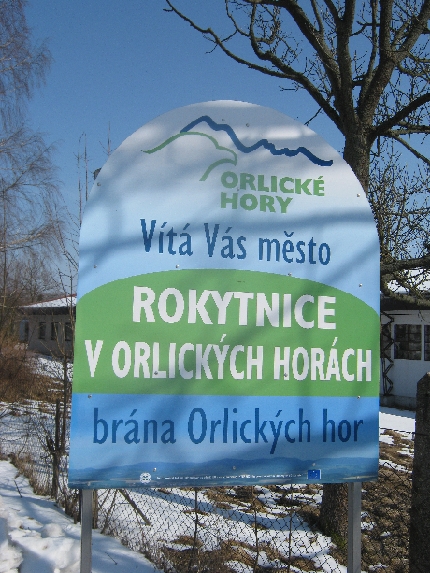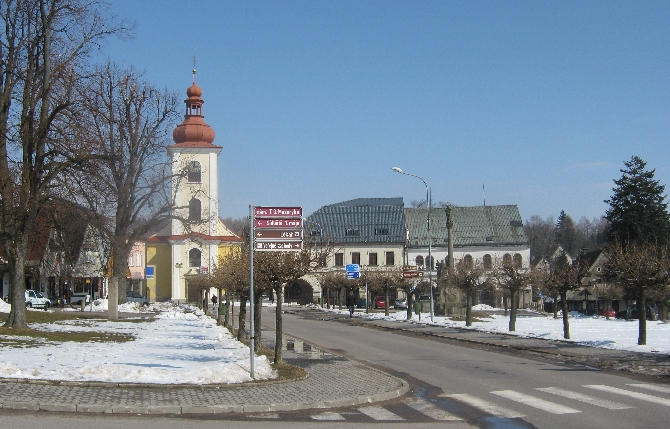
The Czech Republic has one the most dense rail networks in the whole of Europe. One of the very few benefits of over forty years of communist rule is that nearly all of it is still in existence and in use. Unlike in the UK, where over a third of the rail network was made redundant in the 1960s by Dr. Beeching, no one in the Czech Republic ever saw any part of their rail network as being ‘uneconomic’ and therefore needing to be closed down.
On Friday 28th June during our recent holiday in the Orlické hory, we walked around fourteen kilometres from our hotel in Rícky v Orlických horách, all along a waymarked footpath which follows the valley of the Rícka and Zdobnice rivers. At the end of our walk, we arrived in the village of Slatina nad Zdobnici. How did we get back to our hotel without retracing our steps? By a wonderful combination of train and bus.

At the western end of Slatina nad Zdobnici is the village railway station. Here it is in all its glory 🙂 Yes, there is grass growing on the platform and between the railway tracks. But trains still run regularly along the line and a clear timetable was on display. We had a bit of a wait as we had missed the previous train by about fifteen minutes. But right on time, the 14.37 service to Rokytnice v Orlických horách, duly arrived.

As on many branch lines of the Czech rail network, the service was provided by a single diesel rail car. Each one has a name and the one we travelled on was called ‘Verunka’. As the station at Slatina is unmanned, the procedure is to buy your ticket from the guard, once you are on board. Here is ours for the grand sum of 34 Kc – £1.12 at current exchange rates. And yes, that is for the two of us – £0.56 each! The ticket also declares the distance to be travelled – nine kilometres.
When we reached Rokytnice v Orlických horách, which is also the end of the line, we could have virtually straight-away caught a bus from outside the station, all the way back to Rícky v Orlických horách. Instead, we walked a short distance to Penzion Rampušák in the centre of the town, in order to have a well-deserved late lunch and do a little supermarket shopping. But at 17.13, right outside the supermarket, along came the next local bus service, to take us the six kilometres back to Rícky, also for the grand sum of 34 Kc. The joys of Czech public transport – regular, efficient and remarkably cheap!





Yes, we too love the extensive coverage, ease of use and low cost. We really enjoy our jaunts out into the country and other Czech towns.
At first we objected that the out-lying and intercity trains weren’t free for those 70 and over, but we found the fares such good value we now don’t mind paying.
Cheers,
Brilliant isn’t it Michael. Yes – Czech railways (CD) do have a different policy regarding ‘Seniors’ compared to Prague Public Transport (DPP). As I’ve written about previously on this blog, once I celebrated my sixtieth birthday, my cost of travel with the DPP has been much reduced – see http://rickyyates.com/my-diamond-jubilee/ . But when I enquired of CD, about being similarly treated, I discovered that reduced rates for ‘Seniors’ only apply if you are in receipt of a pension 🙁
I love these motoracek trains, they’re very special and symbolic of the Czech Republic. I’ve never really thought about how there is probably a more extensive regional train service in the Czech Republic than in the UK; even though ours is quite extensive too in spite of Dr Beeching. Also, I’ve never really thought about how some of these regional Czech routes would probably be heritage lines if they were in the UK. The heritage lines in the UK are, of course, very well run and maintained but inevitably tend to be quite expensive. I reckon the 34kc you paid could almost be the same figure in pounds for 2 on a heritage railway line in the UK. It’s a bit of an exaggeration but I’m sure you know what I’m trying to say! 🙂
I agree with you Russell and thank you for referring to these diesel rail cars by their correct name – something I didn’t previously know. Sadly, I think your price comparison with the UK is a fairly accurate one rather than being too much of an exaggeration.
Ricky, Your post made me think of one of the few Czech films I’ve seen – ‘Closely Observed Trains’ or ‘Ost?e sledované vlaky ‘. A magical and very moving piece of cinema. Have you seen it?
I know it’s a while since I’ve commented but I do read all your posts.
Best Wishes
Tim
Thanks Tim – No – I haven’t seen the film though I’ve just educated myself by reading the Wikipedia article about it! I almost certainly could find a DVD of it here, but probably only in Czech 🙁 No doubt you copied & pasted the title of the film in Czech & have suffered from the problem I commented on previously. For reasons that are beyond my comprehension, the technical set-up of the blog can only cope with some Czech diacritics. Those it cannot cope with appear as ‘?’ as has happened here!
I’m glad to know that you are still a regular visitor – comments are always very welcome!
Motorak, motoracek. Or, as my railway-educated father calls them, Bzmot (it’s their register-type, these numbered 810). And interestingly, I knew some trains had names (I like this practice), but I think this is the first time I see one on a Bzmot!
They do not make it into that film, by the way, because that takes place during WW2 and these are newer. One of these made it into Kolya, though!
With a railway-educated father, I cannot but love travelling by train. More so with the dense network we have here. As demonstrated above, I’m even able to recognise some types; some of the types, usually locomotives, have names, like Zamracena, Brejlovec, Zehlicka…
Hi Hana – I didn’t know you were a train enthusiast too! And like you, I very much approve of the idea of giving each one a name.
I fully understand that the motoracek trains would not appear in a film set during WW2. What I think my nephew Tim was more referring to was the location where ‘Closely Observed Trains’ was filmed. There is a great similarity between the railway station at Lodenice used for the film, and my photograph of the railway station at Slatina nad Zdobnici.
I have very fond memories of the wonderful efficiency and (at my age) cheapness of public transport in Prague, though I never managed to make it out of the city. The fares you quote are unbelievably low by current UK standards. 🙁
Tim’s comment reminded me that “Closely Observed Trains” was one of the films I saw and much enjoyed at our local film society in Mid-Wales in the 1970s. I hadn’t thought about it in many years.
The efficiency and low cost (especially for those of us of a certain age 🙂 ), of public transport in Prague is, as you say Perpetua, absolutely wonderful. But the beauty is, it extends across the whole country. I was amazed to be only charged CZK 34 for the two of us for our train ride. CZK 34 each, would still have been cheap.
In view of your comment Perpetua, together with those of Tim & Hana, I think I’ll have to try & find a DVD of ‘Closely Observed Trains’ as it sounds a fascinating film & well worth watching.
Hi Ricky, The book “Closely Observed Trains” is worth reading as well. In fact, anything by Hrabal is worth reading.
The Czech title is Ostre Sledovane Vlaky and it’s easy to find in any of those little DVD stores around town. My copy cost 49 CZK. It won the foreign language Oscar in 1967. Jiri Menzel, the director, has adapted a lot of other works by Hrabal including Postriziny, (“Cutting it Short”, although I’m told Postriziny is almost impossible to translate), which is about the boy growing up in the brewery – he has a fabulous Uncle Pepin – my favourite character in Czech film – and the beautiful mother whose hair is the source of erotic admiration from the men of the town, Obsluhoval jsem anglického krále (“I Served the King of England”), Slavnosti snezenek (“The Snowdrop Festival”) and Skrivánci na niti (“Larks on a String”). I’m sure you’ll have seen some of those on TV. They’re all easily available on DVD, most of them are subtitled too.
In the late 90s I took a girlfriend to watch a double bill of Closely Observed Trains and Perlicky na dne (“Pearls from the Deep”), a portmanteau film from the mid 60s, also adapted from Hrabal stories. 3 and a half hours of subtitled Czech New Wave classics. The relationship didn’t last long.
One final thing about Hrabal – he grew up in the town of Nymburk where his father ran the local brewery and that’s why their beer is called Postriziny and the 10 degree is Pepinova, after the uncle. Hrabal’s image is on the labels of the beer. The beer itself is OK.
Thank you David – both for this interesting background information about the writings of Hrabal, as well as details of your relationship history with Czech young ladies 🙂 Of course, being the Czech Republic, there had to be a connection with beer! Btw – I’ve edited your comment to include the correction you posted a few minutes later.
She was British, Ricky.
David – my apologies for the incorrect nationality. Re-reading your comment, I suspect the event you describe took place in the UK rather than the CR, something that didn’t register with me when I read it the first time.
Concerning Czech films on DVDs, my experience (also in purchasing the “Sakali leta” one for you+Sybille to watch something entertaining about Dejvice 🙂 ), is that even those cheap ones sold at news-stands may include English subtitles and all you have to do is check the boxes at the bottom of the back cover where length, format etc. are described – then under “titulky” you’ll see, whether it includes “EN” and you’re good to go 🙂
I do agree with the above posts that many Czech films from the 1960’s are very beautiful and artistic and definitely worth watching. Any film based on a book by Hrabal is bound to be an experience as he was one of the writers who managed to capture both some interesting Czech characters as well as poetic things in life.
Many thanks Katka, both for this helpful advice about finding DVDs with English subtitles, as well as endorsing some of the earlier comments.
Re: the untranslability of Postrižiny: It was, allegedly, a sort of a coming-of-age ritual/custom (or maybe earlier, not of age yet but already expected to be more grown-up), when a boy’s hair was cut short. I don’t have any resources to back this up; anyway, I think it was already a dead custom by the time Hrabal wrote the book, and he’s using it metaphorically. There’s no boy in the book or the film, just the couple who are to become his parents (the woman is the narrator of the book, and partly also the film).
Thanks for this additional information Hana. Interesting to see that a post which was originally about the joys of Czech public transport, has become a discussion board about classic Czech films 🙂